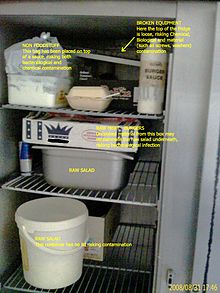Food poisoning
Food poisoning is when someone gets sick from eating food or drink that has gone bad or is contaminated.[1] There are two kinds of food poisoning, either by poisoning with a toxic agent or by an infectious agent. Food infection is when the food contains bacteria or other microbes which infect the body after it is eaten. Food intoxication is when the food contains toxins, including bacterially produced exotoxins, which can happen even when the microbe that produced the toxin is no longer present or able to cause infection. Even though it is commonly called "food poisoning", most cases are caused by a variety of pathogenic bacteria, viruses, prions or parasites that contaminate food,[2] rather than chemical or natural toxins which are what we usually call poison. According to the Centers for Disease Control and Prevention, about 76 million people in the United States become ill from the food they eat, and about 5,000 die every year.[3]

Signs and symptoms
changeSymptoms start within hours to many days after eating. Depending on what the cause of the poisoning was, they can include one or more of the following: nausea, abdominal pain, vomiting, diarrhea, gastroenteritis, fever, pain in the head or fatigue.
In most cases the body is able to get better after a short period of acute food poisoning causing minor discomfort and illness. Food borne illnesses can result in permanent health problems or even death, especially for people at high risk, including babies, young children, pregnant women (and their fetuses), elderly people, sick people and others with weak immune systems.
Food borne illness due to Campylobacter, Yersinia, Salmonella or Shigella infection is a major cause of reactive arthritis, which typically occurs 1–3 weeks after diarrheal illness. Similarly, people with liver disease are especially susceptible to infections from Vibrio vulnificus, which can be found in oysters or crabs.
Tetrodotoxin poisoning from reef fish and other animals shows up very quickly in symptoms such as numbness and shortness of breath, and is often fatal.
Related pages
changeReferences
change- ↑ food poisoning at Dorland's Medical Dictionary
- ↑ "Disease Listing, Foodborne Illness, General Information | CDC Bacterial, Mycotic Diseases". cdc.gov. Retrieved 14 July 2010.
- ↑ "Ten Common Food Poisoning Risks - Well Blog - NYTimes.com". well.blogs.nytimes.com. Retrieved 14 July 2010.
Other websites
change- Descriptions of the main microbes that make food unsafe Archived 2011-07-07 at the Wayback Machine
- How long does food poisoning last? Archived 2012-04-17 at the Wayback Machine